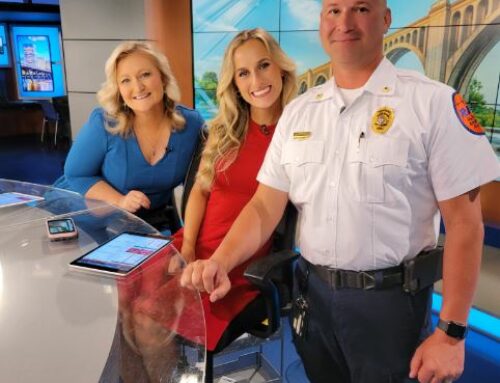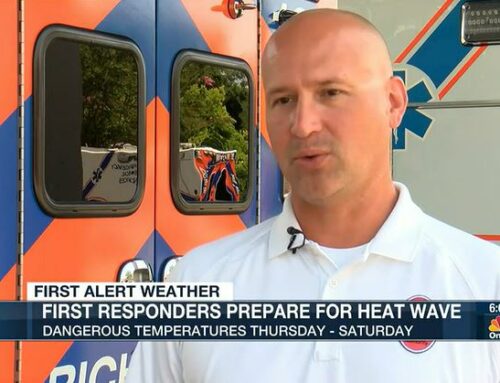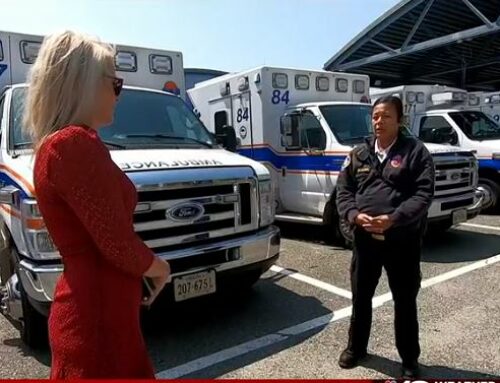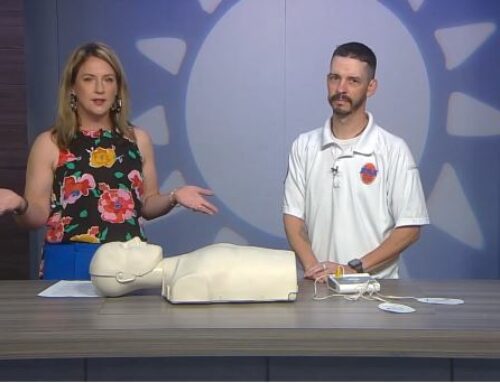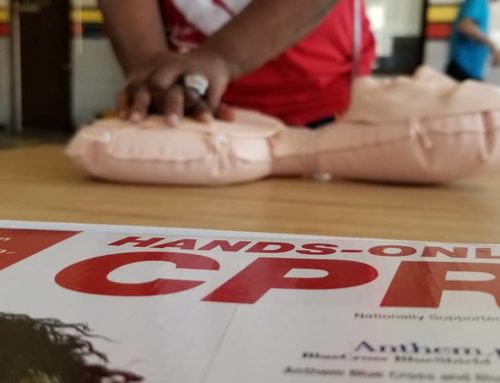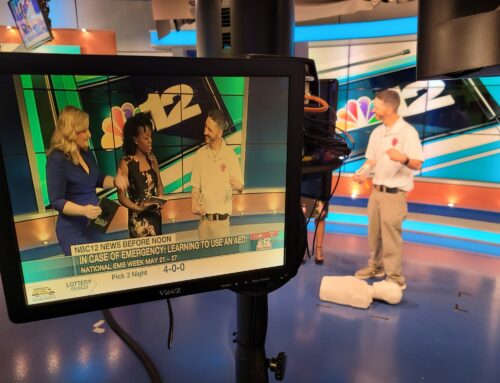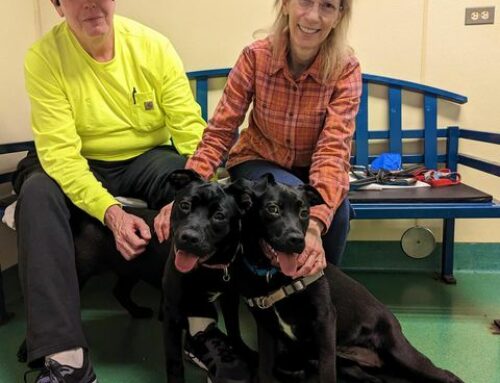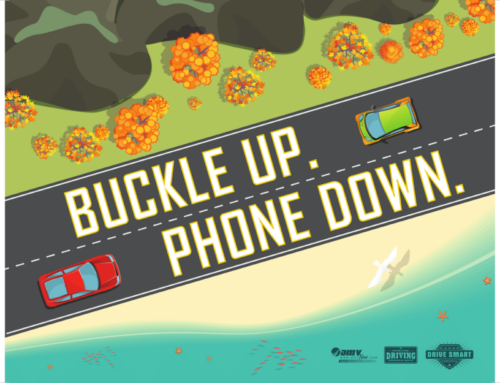By Joseph P. Ornato, MD, FACP, FACC, FACEP, Charles Siegel, Rich Lindfors, NRP, EMD-Q, EMD-I and Danny Garrison, NRP, EMD-Q, EMD-I
This article originally appeared on jems.com
Almost 350,000 adults suffer an out-of-hospital cardiac arrest in the USA each year.1 Although prehospital providers save approximately 10% of “EMS-worked” arrests. However, these cases actually represent only half of all events (the remainder are dead on EMS arrival at the scene and are not “worked”). So, the actual survival rate is about 5%.
The American Heart Association’s concept of a “chain of survival” is the basis for our strategy for treating out-of-hospital cardiac arrest victims.2 Despite improvements in community preparedness and EMS response (e.g., dispatcher “hands-only CPR”, layperson CPR training, deployment of automated external defibrillators), survival rates in most communities are relatively flat.1
The purpose of this article is to explore the consequences of the difference between the “EMS response time interval” and the initiation of highly time-dependent treatments such as defibrillation, epinephrine, and antiarrhythmic drug administration by EMS providers.
We will demonstrate how the physical time-to-EMS provider treatment harshly compromises the effectiveness of such treatments and discuss how the next frontier in EMS may be to “cheat time” through 911 dispatcher-directed bystander administration of drugs and devices delivered by drone.
Arrest Location and Initial Documented Cardiac Arrest Rhythm are Important Determinants of Survival
A large percentage of neurologically intact survivors have their cardiac -arrest in a public place where the event is witnessed and the initial recorded rhythm is shockable (ventricular tachycardia or pulseless ventricular fibrillation).3
Survival for patients with an initially shockable rhythm decreases 10% for every minute delay in defibrillation.2, 4 Dispatcher-directed, “hands-only” bystander CPR can approximately double survival.5
Survival for patients with an initially shockable rhythm decreases 10% for every minute delay in defibrillation. Dispatcher-directed, “hands-only” bystander CPR can approximately double survival.
An initial shockable rhythm is present on EMS monitor/defibrillators in only about 20% of all (i.e., public and non-public location) cases and the incidence is not changing significantly.1 However, an initially shockable rhythm is likely present a much higher percent of the time, but decays into fine ventricular fibrillation/asystole or pulseless electrical activity (PEA) by the time EMS providers get to the patient and attach a monitor/defibrillator. A North Carolina cardiac arrest registry has shown that the presence of an initially shockable rhythm decreases 2% for every minute delay in the EMS response time interval.6
Considering only witnessed cardiac arrests occurring in a public location, 79% of initial documented cardiac arrest rhythms are shockable when an AED is applied by a bystander, but only 35% of initial rhythms are shockable when no AED is applied and the first cardiac arrest rhythm is recorded after EMS arrives and applies a monitor/defibrillator. 7 Bystander-delivered shocks using an AED before EMS arrival triple (34 vs.12%) survival-to-hospital discharge compared to EMS defibrillation after arrival on scene.7
79% of initial documented cardiac arrest rhythms are shockable when an AED is applied by a bystander, but only 35% of initial rhythms are shockable when no AED is applied and the first cardiac arrest rhythm is recorded after EMS arrives and applies a monitor/defibrillator.
Bystander-delivered shocks using an AED before EMS arrival triple (34 vs.12%) survival-to-hospital discharge compared to EMS defibrillation after arrival on scene.
In contrast, the initial cardiac arrest rhythm documented by EMS providers is shockable in only 21% cases occurring in a non-public location, resulting in a survival-to-hospital discharge of only 5%, even though the EMS response time interval between the two location groups is not significantly different (5.6 vs 5.0 min).7
The likely explanation for the difference in the initial shockable rhythm and survival incidence between public and non-public location cardiac arrests is that a person who has their event in the home is typically older and more likely to be alone, or to have a chronic illness that limits or precludes participation in activities outside the home.7
EMS Response Time vs. Time-to-Treatment Intervals
Although the arrest location is an essential determinant of survival, it is not changeable. In contrast, the time interval between arrest onset and return of spontaneous circulation (ROSC) is a vital outcome determinant and influenced by the rapidity of bystander and EMS treatments.
The reported EMS “response time interval” does not reflect the actual “biological response time interval” from arrest onset to initial treatments such as defibrillation, antiarrhythmics and epinephrine. The latter interval is composed of multiple small delays leading up to a long interval before potentially effective EMS treatments can be applied even in the best of EMS systems (Figure 1).

Time is the Enemy
The median time interval from 911 call receipt to first defibrillation was 12-15 min In the National Institutes of Health (NIH) sponsored Resuscitation Outcomes Consortium (ROC) ALPS study involving 3,206 out-of-hospital cardiac arrest patients with an initially shockable rhythm treated by providers from 268 high-quality EMS agencies in the US and Canada.
The median time interval from 911 call receipt to the first antiarrhythmic drug administration was 19-22 minutes. The study showed no difference in survival when unwitnessed cardiac arrest patients were treated with antiarrhythmic drugs (amiodarone or lidocaine) vs. saline placebo. However, witnessed cardiac arrest patients (where the time to initial treatment was likely shorter) had improved survival when antiarrhythmic drugs rather than placebo were administered.
The median time interval from 911 call receipt to first defibrillation was 12-15 min in the National Institutes of Health (NIH) sponsored Resuscitation Out-comes Consortium (ROC) ALPS study.
Witnessed cardiac arrest patients (where the time to initial treatment was likely shorter) had improved survival when antiarrhythmic drugs rather than placebo were administered.
Similarly, the current “controversy” over whether prehospital use of epinephrine is helpful or harmful all depends on the time to initial EMS administration.8-13 The average time interval from 911 call receipt to the first dose of epinephrine is often quite long and likely plays a major role in whether epinephrine is beneficial.8-10, 12-16
When epinephrine is administered early, (<5-10 min) after arrest onset, it improves neurologically intact survival. When given later, it improves ROSC and hospital admission rates, but survival-to-hospital discharge is unchanged, with more survivors having neurological impairment. The likely explanation is that delayed administration of epinephrine may be able to restart the heart after the brain has suffered irreversible damage.
When epinephrine is administered early, (<5-10 min) after arrest onset, it im-proves neurologically intact survival.
For example, the Paramedic2 prehospital clinical trial randomized 8,014 out-of-hospital cardiac arrest patients to treatment with epinephrine vs. saline placebo. 14 The trial was conducted by paramedics from five National Health Service ambulance services in the United Kingdom which are known for providing excellent prehospital clinical care comparable to our best US systems. This trial, the largest of its kind, found no significant difference in the proportion of patients who survived until hospital discharge with a favorable neurological outcome (2.2 vs. 1.9%) between patients who received epinephrine vs. placebo.
The median time intervals between emergency call receipt at dispatch until arrival “at scene” (6.7 vs. 6.6 minutes in the epinephrine vs. placebo groups) were comparable to excellent US EMS systems. However, the average time interval from emergency call receipt to first dose administration of epinephrine or placebo was 23 minutes.
How Can We “Cheat Time?”
Conventional wisdom is to add more EMS resources and optimize each step in the response time process. Although a noteworthy goal, many of the “high-performance” EMS agencies involved in the above studies have already done that to the best of their ability and affordability.
But, simply adding more resources is not fiscally reasonable. A more cost-effective solution is to have trained 911 dispatcher drone pilots deliver treatment materials to a bystander caller rapidly by drone and direct their administration while first responders/EMS providers are on the way.
We are using these two examples (early defibrillation and administration of naloxone to an opioid overdose victim) to illustrate the problem and potential opportunity for improvement. In some communities, occult opioid overdoses account for 14% of prehospital cardiac arrests.17 What starts as a respiratory arrest from the overdose turns into a cardiac arrest if assisted ventilation and/or naloxone are not provided promptly. Despite programs making effective reversal treatment available to friends and family of opioid-addicted individuals, bystanders administer naloxone to the victim in <5% of cases.18
Delivering intranasal naloxone spray to the bystander rapidly by a 911 drone pilot dispatcher, with direction on its administration, has the potential to prevent short-duration respiratory insufficiency from deteriorating to cardiac arrest before first responder/EMS patient arrival.
The City of Richmond, Virginia is 62 square miles. Let’s hypothetically set a goal of having 911 dispatchers direct a bystander to fetch and administer treatment with a pre-positioned AED or intranasal naloxone within 2 min as EMS is responding to the call. Using this example, we would have to pre-position 7,750 AED/naloxone units within the City at a cost of almost $12M to meet the <2 min goal. It would take only five commercial drones to deliver the devices to the bystander in <2 min at a total cost of <$60,000. The drone solution is roughly 200 times less expensive than prepositioning such equipment.
Can We Do This Today?
The short answer is “no”, although several EMS agencies in the US and Canada (e.g., Richmond, VA [Figure 2]; Salt Lake City, UT; Toronto, CA)19-21, Sweden22, 23, and other locations/agencies are conducting research under current Federal Aviation Administration (FAA)/European Aviation Safety Agency (EASA) regulations that will hopefully chart the path for this futuristic approach.

The major obstacle today includes current regulations. Concerns for safety, prohibit operations such as drone flight out of line of sight of its pilot, including at night, and over densely populated areas, and within five nautical miles of a towered airport.
The Future
When it comes to treating life-threatening illnesses or injury, time is our enemy. Today’s EMS service delivery models cannot shift the survival curve dramatically at an affordable cost. The next frontier in EMS will be to enhance bystander effectiveness through 911 dispatcher-delivered drugs/devices & real-time direction of their use.
In the US, the FAA is working with several industries to explore more robust integration of commercial drones into the National Airspace System (NAS). The FAA recently approved limited package delivery services under its Part 135 regulations (the same rules that govern airline operations) for Google Wing and United Parcel Service.
We can’t currently track and identify drones with the transponder system used to track higher-flying aircraft because drones are required to fly at low altitudes. The FAA is establishing a “Remote ID” requirement for commercial drones requiring development and deployment of a real-time tracking infrastructure in populated areas. So, other than highly controlled research projects conducted under an FAA waiver, widespread deployment of EMS drone delivery of medical devices and drugs to bystanders is not yet possible today, but almost certain to become an extension of EMS care in the near future.
Dr. Ornato, VCU’s College of Engineering, and a drone-pilot training company (VirginiaUAS, Richmond, VA) are collaborating with RAA on a federally funded pilot study developing hardware, software, and a sophisticated 911 computer added dispatch interface. The system is designed to allow RAA FAA-certified drone pilots to rapidly launch and delivery emergency medical equipment, like naloxone and AEDs, to bystanders by a small unmanned aerial vehicle (sUAV, AKA “drone”) while EMS first responders and paramedics are enroute to the scene.

The system is in the developmental/testing phase and will require significant FAA regulatory evolution and approval before a planned real-world testing phase can be conducted.
References
- Virani SS, Alonso A, Benjamin EJ, Bittencourt MS, Callaway CW, Carson AP, Chamberlain AM, Chang AR, Cheng S, Delling FN, Djousse L, Elkind MSV, Ferguson JF, Fornage M, Khan SS, Kissela BM, Knutson KL, Kwan TW, Lackland DT, Lewis TT, Lichtman JH, Longenecker CT, Loop MS, Lutsey PL, Martin SS, Matsushita K, Moran AE, Mussolino ME, Perak AM, Rosamond WD, Roth GA, Sampson UKA, Satou GM, Schroeder EB, Shah SH, Shay CM, Spartano NL, Stokes A, Tirschwell DL, VanWagner LB, Tsao CW, American Heart Association Council on E, Prevention Statistics C, Stroke Statistics S. Heart Disease and Stroke Statistics-2020 Update: A Report From the American Heart Association. Circulation 2020;141:e139-e596.
- Cummins RO, Ornato JP, Thies WH, Pepe PE. Improving survival from sudden cardiac arrest: the “chain of survival” concept. A statement for health professionals from the Advanced Cardiac Life Support Subcommittee and the Emergency Cardiac Care Committee, American Heart Association. Circulation 1991;83:1832-47.
- Weisfeldt ML, Everson-Stewart S, Sitlani C, Rea T, Aufderheide TP, Atkins DL, Bigham B, Brooks SC, Foerster C, Gray R, Ornato JP, Powell J, Kudenchuk PJ, Morrison LJ, Resuscitation Outcomes Consortium I. Ventricular tachyarrhythmias after cardiac arrest in public versus at home. N Engl J Med 2011;364:313-21.
- Valenzuela TD, Roe DJ, Nichol G, Clark LL, Spaite DW, Hardman RG. Outcomes of rapid defibrillation by security officers after cardiac arrest in casinos. N Engl J Med 2000;343:1206-9.
- Song J, Guo W, Lu X, Kang X, Song Y, Gong D. The effect of bystander cardiopulmonary resuscitation on the survival of out-of-hospital cardiac arrests: a systematic review and meta-analysis. Scand J Trauma Resusc Emerg Med 2018;26:86.
- Renkiewicz GK, Hubble MW, Wesley DR, Dorian PA, Losh MJ, Swain R, Taylor SE. Probability of a shockable presenting rhythm as a function of EMS response time. Prehosp Emerg Care 2014;18:224-30.
- Pollack RA, Brown SP, Rea T, Aufderheide T, Barbic D, Buick JE, Christenson J, Idris AH, Jasti J, Kampp M, Kudenchuk P, May S, Muhr M, Nichol G, Ornato JP, Sopko G, Vaillancourt C, Morrison L, Weisfeldt M, Investigators ROC. Impact of Bystander Automated External Defibrillator Use on Survival and Functional Outcomes in Shockable Observed Public Cardiac Arrests. Circulation 2018;137:2104-13.
- Donnino MW, Salciccioli JD, Howell MD, Cocchi MN, Giberson B, Berg K, Gautam S, Callaway C, American Heart Association’s Get With The Guidelines-Resuscitation I. Time to administration of epinephrine and outcome after in-hospital cardiac arrest with non-shockable rhythms: retrospective analysis of large in-hospital data registry. BMJ 2014;348:g3028.
- Hagihara A, Hasegawa M, Abe T, Nagata T, Wakata Y, Miyazaki S. Prehospital epinephrine use and survival among patients with out-of-hospital cardiac arrest. JAMA 2012;307:1161-8.
- Kudenchuk PJ. Early epinephrine in out-of-hospital cardiac arrest: is sooner better than none at all? Resuscitation 2013;84:861-2.
- Nakahara S, Tomio J, Nishida M, Morimura N, Ichikawa M, Sakamoto T. Association between timing of epinephrine administration and intact neurologic survival following out-of-hospital cardiac arrest in Japan: a population-based prospective observational study. Acad Emerg Med 2012;19:782-92.
- Koscik C, Pinawin A, McGovern H, Allen D, Media DE, Ferguson T, Hopkins W, Sawyer KN, Boura J, Swor R. Rapid epinephrine administration improves early outcomes in out-of-hospital cardiac arrest. Resuscitation 2013;84:915-20.
- Dumas F, Bougouin W, Geri G, Lamhaut L, Bougle A, Daviaud F, Morichau-Beauchant T, Rosencher J, Marijon E, Carli P, Jouven X, Rea TD, Cariou A. Is epinephrine during cardiac arrest associated with worse outcomes in resuscitated patients? J Am Coll Cardiol 2014;64:2360-7.
- Perkins GD, Ji C, Deakin CD, Quinn T, Nolan JP, Scomparin C, Regan S, Long J, Slowther A, Pocock H, Black JJM, Moore F, Fothergill RT, Rees N, O’Shea L, Docherty M, Gunson I, Han K, Charlton K, Finn J, Petrou S, Stallard N, Gates S, Lall R, Collaborators P. A Randomized Trial of Epinephrine in Out-of-Hospital Cardiac Arrest. N Engl J Med 2018;379:711-21.
- Perkins GD, Kenna C, Ji C, Deakin CD, Nolan JP, Quinn T, Fothergill R, Gunson I, Pocock H, Rees N, Charlton K, Finn J, Gates S, Lall R. The effects of adrenaline in out of hospital cardiac arrest with shockable and non-shockable rhythms: Findings from the PACA and PARAMEDIC-2 randomised controlled trials. Resuscitation 2019;140:55-63.
- Perkins GD, Quinn T, Deakin CD, Nolan JP, Lall R, Slowther AM, Cooke M, Lamb SE, Petrou S, Achana F, Finn J, Jacobs IG, Carson A, Smyth M, Han K, Byers S, Rees N, Whitfield R, Moore F, Fothergill R, Stallard N, Long J, Hennings S, Horton J, Kaye C, Gates S. Pre-hospital Assessment of the Role of Adrenaline: Measuring the Effectiveness of Drug administration In Cardiac arrest (PARAMEDIC-2): Trial protocol. Resuscitation 2016;108:75-81.
- Tseng ZH, Olgin JE, Vittinghoff E, Ursell PC, Kim AS, Sporer K, Yeh C, Colburn B, Clark NM, Khan R, Hart AP, Moffatt E. Prospective Countywide Surveillance and Autopsy Characterization of Sudden Cardiac Death: POST SCD Study. Circulation 2018;137:2689-700.
- Mattson CL, O’Donnell J, Kariisa M, Seth P, Scholl L, Gladden RM. Opportunities to Prevent Overdose Deaths Involving Prescription and Illicit Opioids, 11 States, July 2016-June 2017. MMWR Morb Mortal Wkly Rep 2018;67:945-51.
- Cheskes S, McLeod SL, Nolan M, Snobelen P, Vaillancourt C, Brooks SC, Dainty KN, Chan TCY, Drennan IR. Improving Access to Automated External Defibrillators in Rural and Remote Settings: A Drone Delivery Feasibility Study. J Am Heart Assoc 2020;9:e016687.
- Ornato JP, You AX, McDiarmid G, Keyser-Marcus L, Surrey A, Humble JR, Dukkipati S, Harkrader L, Davis SR, Moyer J, Tidwell D, Peberdy MA. Feasibility of bystander-administered naloxone delivered by drone to opioid overdose victims. Am J Emerg Med 2020;38:1787-91.
- Pulver A, Wei R, Mann C. Locating AED Enabled Medical Drones to Enhance Cardiac Arrest Response Times. Prehosp Emerg Care 2016;20:378-89.
- Claesson A, Backman A, Ringh M, Svensson L, Nordberg P, Djarv T, Hollenberg J. Time to Delivery of an Automated External Defibrillator Using a Drone for Simulated Out-of-Hospital Cardiac Arrests vs Emergency Medical Services. JAMA 2017;317:2332-4.
- Claesson A, Fredman D, Svensson L, Ringh M, Hollenberg J, Nordberg P, Rosenqvist M, Djarv T, Osterberg S, Lennartsson J, Ban Y. Unmanned aerial vehicles (drones) in out-of-hospital-cardiac-arrest. Scand J Trauma Resusc Emerg Med 2016;24:124.


